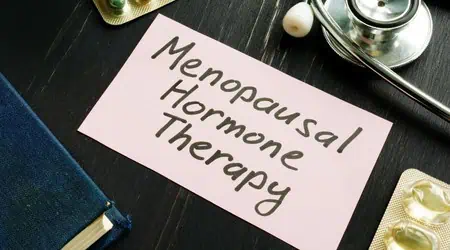
If you’re going to take hormone therapy, it’s safer to take hormones that are identical to human hormones. In other words, hormones that are body-identical or bioidentical. The concept of bioidentical used to be controversial but is now conventional and mainstream.
In episode five of my podcast/YouTube video, I discuss hormone therapy, including why the concept of bioidentical was controversial when it didn’t need to be; oral micronized progesterone for heavy periods, mood, sleep, and perimenopausal migraines; and some quick facts about body-identical estrogen.
Also available wherever you get your podcasts.
Transcript
Here’s a simple fact. If you’re going to take hormone therapy, it’s safer to take hormones that are identical to human hormones. In other words, hormones that are body-identical or bioidentical. The concept of bioidentical used to be controversial but is now conventional and mainstream.
Welcome back to the podcast. I’m your host, Lara Briden, a naturopathic doctor and author of the books Period Repair Manual and Hormone Repair Manual.
It’s autumn here now in Christchurch, New Zealand, where I live. The days are getting shorter, and so…I’ve just booked my annual flight home to Canada, where I’m from. And if you follow me on Instagram, you can get ready for a few more photos of me hiking in the mountains.
Okay. So, this episode is about natural hormone therapy, which can mean hormone therapy for perimenopause and menopause. It can also mean hormone therapy—particularly progesterone therapy—for PCOS, heavy periods, migraines, and other period problems.
A couple of things to get out of the way.
First, I’m talking about body-identical hormones, not contraceptive drugs. Which as I explained in episode one, are only “hormone-like”—not molecularly identical to actual hormones.
And second, I’m going to focus on estrogen and progesterone, but of course, there are other body-identical steroid hormones like DHEA, cortisol, testosterone, pregnenolone, and more. And then there’s thyroid hormone and melatonin, which are conventionally body-identical. But if you want more information about any of that, please ask me in my forum.
For now, let’s look at body-identical estrogen and progesterone and why the term bioidentical has been controversial when it didn’t need to be. Because, in case you’re wondering, body-identical and bioidentical mean exactly the same thing. That is hormones—in this case, estrogen and progesterone—that are molecularly identical to estradiol, our main estrogen, and progesterone.
The modern consensus is that body-identical estradiol and progesterone are safer than the hormone-like drugs used in old-style hormone replacement therapy. That’s especially true for progesterone, which, for example, probably reduces the risk of breast cancer, while all types of progestins slightly increase the risk of breast cancer. And there are other differences between progesterone and progestins, which I discuss on my blog.
The safety of body-identical progesterone has actually been evident in the research for a couple of decades. But like so many things in medicine, it took a while for that research to reach doctors’ offices. Rewind even six years, and (depending on your country) you’d still find that the official medical consensus—at that time—was that there was no difference between progesterone and progestins in either effect or safety. While all along, there were some doctors—including me—who were convinced, ahead of the research, that progesterone was safer than progestins. And so found a way for our patients to access body-identical progesterone via compounding pharmacies.
That alternative approach to hormone therapy was referred to as “bioidentical hormone therapy” or “natural hormone therapy.” But of course, natural progesterone was natural only in that it was identical to human progesterone and, therefore, safer. “Natural” hormone therapy was always synthetic in that it was made in a lab from a plant sterol precursor, as are all types of hormone therapy and contraceptive drugs—body-identical or not.
And that’s where the controversy began. Many experts did not think it was a good idea to use unregulated, compounded hormones in place of regulated, approved products. And in that, they had a point. Except that, back then, there was literally no other way to access body-identical progesterone. The experts also said—back then—that there was not yet definitive proof that body-identical hormones were safer, which was true. The evidence was not definitive, but it did exist. And looking back, I feel the assertion by some experts that bioidentical was; therefore, a deception was in itself not true. Because although bioidentical as safer was not yet proven, it was entirely biologically plausible.
Hormones that are identical to human hormones are safer than hormone-like drugs. That was true back then, even before the definitive scientific proof. And it’s true now.
So, thank goodness the research did eventually catch up. And in 2016 (using Australia as an example), body-identical progesterone became available as the regulated product Prometrium, which is one of the brand names for “oral micronized progesterone,” which is now the preferred recommendation for the progesterone part of menopausal hormone therapy. Because it’s safer.
So, what does “oral micronized” progesterone mean? It just refers to a preparation of progesterone that is micronized or essentially emulsified to facilitate oral absorption. Without such preparation, progesterone cannot be absorbed orally, which is actually why progestins were invented in the first place.
In general, oral progesterone is preferable to topical progesterone or progesterone cream. Certainly, that’s true if you’re using progesterone as the progesterone part of menopausal hormone therapy because you need enough progesterone to enter the body and protect the uterine lining from the estrogen part of your hormone therapy. Progesterone cream has been tested for that purpose and found to be not able to deliver enough progesterone to protect the uterine lining. So, if you hear an expert say that progesterone cream has been studied and found to be ineffective, that’s what she is referring to.
Progesterone cream can, however, be helpful for other purposes, such as taking the edge off perimenopausal mood symptoms or migraines. There’s not yet scientific evidence to support that effect, but that could be because there has not yet been a study to look at progesterone cream for that purpose.
All that said, for most things, oral progesterone is more effective than a cream, especially for heavy periods and especially for sleep problems. And that’s because oral progesterone has greater conversion to the sedating neurosteroid metabolite allopregnanolone. That makes oral progesterone more sedating or tranquillizing than topical progesterone or other ways of taking progesterone. In fact, I just received a comment on my blog from a reader who switched from Prometrium to progesterone troches or lozenges and is now “no longer experiencing the wonderful calm sleepy feeling” she had with Prometrium.
In my book Hormone Repair Manual, I talk a lot about using oral micronized progesterone for heavy bleeding, sleep, mood, migraines, breast pain, and night sweats. And provide what I hope are helpful sections about “how to speak with your doctor.” Because while progesterone cream is available over-the-counter in some countries, progesterone capsules always require a doctor’s prescription. As a tip, your doctor will be more likely to prescribe progesterone for heavy periods or bleeding problems than she will for mood, sleep, or migraines. So, it might be simplest to just focus on any bleeding symptom. Your doctor will also be more likely to prescribe progesterone plus estrogen. So, you could take the strategy of accepting both prescriptions and then (if you want) start with just the progesterone part. And one more tip: Always ask for progesterone by the brand name Prometrium or Utrogestan (depending on your country), and avoid the term “natural progesterone.”
Finally, oral micronized progesterone, or Prometrium, can be used for PCOS, which I discuss in a blog post and a scientific paper that I’ll link to in the show notes.
Now, for a little about body-identical estrogen. Which, of course, can be helpful for menopause and also for long-standing hypothalamic amenorrhea or relative energy deficiency in sport. We’ll look at each, starting with hypothalamic amenorrhea, which is, of course, primarily caused by undereating so the main treatment is to eat more to regain ovulation and therefore be able to make your own estrogen. However, if you’ve been without your period for years, your doctor may want to prescribe body-identical estrogen and progesterone just as an interim measure to protect your bones. The pill used to be used for that purpose, but now body-identical hormones are the evidence-based approach.
Next, estrogen therapy for menopause—keeping in mind that many of the symptoms of perimenopause are actually from high estrogen, not low. But low estrogen does eventually come into it, of course. And some women can be helped by body-identical estradiol—at least for a while. Estrogen therapy can also reduce the risk of osteoporosis. We don’t have time to go into all the ins and outs of who needs estrogen and for how long. I cover that in Hormone Repair Manual, and of course, you should consult your doctor about your individual health situation.
For now, let’s look at five things about modern estrogen therapy: four uncontroversial things; and one slightly controversial.
First, uncontroversially, most, but not all, modern estrogen therapy is body-identical estradiol, which is good and very different from the old-school Premarin estrogen medication.
Second. Uncontroversially, topical estradiol in the form of a patch or gel is generally safer than oral estrogen, especially for clotting risk.
Third. Uncontroversially, the combination of modern topical estradiol therapy plus oral micronized progesterone is pretty safe. Specifically, in terms of breast cancer risk, for example, modern estrogen therapy is safer than moderate alcohol intake.
Fourth. Uncontroversially, vaginal estrogen is also body-identical and can be very helpful for dryness and other symptoms of the genitourinary syndrome of menopause or GSM. And vaginal estrogen carries no breast cancer risk.
Finally, the one controversial point about estrogen. In general, if you’re going to take estrogen, I think it’s better to take it together with body-identical progesterone—even if you don’t have a uterus. The reason, which I explain in my book, is that progesterone is good for breasts and usually good for mood and can, therefore, shelter you from some of the possible side effects and risks of estrogen. Vaginal estrogen, however, can be taken on its own without progesterone.
Okay. The main takeaway is that body-identical hormone therapy just means hormones that are identical to human hormones. And that body-identical estrogen and progesterone prescriptions are fairly easy to access these days as the conventional products of Estradot, Prometrium, Utrogestan, and others. For a list of all the body-identical brands, see my blog post in the show notes. And you can also ask me in my forum at LaraBriden.com.
And if you’re a practitioner who treats women, consider coming along to my upcoming online workshop called Metabolic health and vitality for women over 40. Where (among other things) I’ll discuss why estrogen is a weight loss hormone. The link to the workshop is in the show notes.
I hope that’s been helpful, and thanks so much for listening. Please share and leave a review. And I’ll see you next time when I’ll discuss how to diagnose and reverse insulin resistance.

